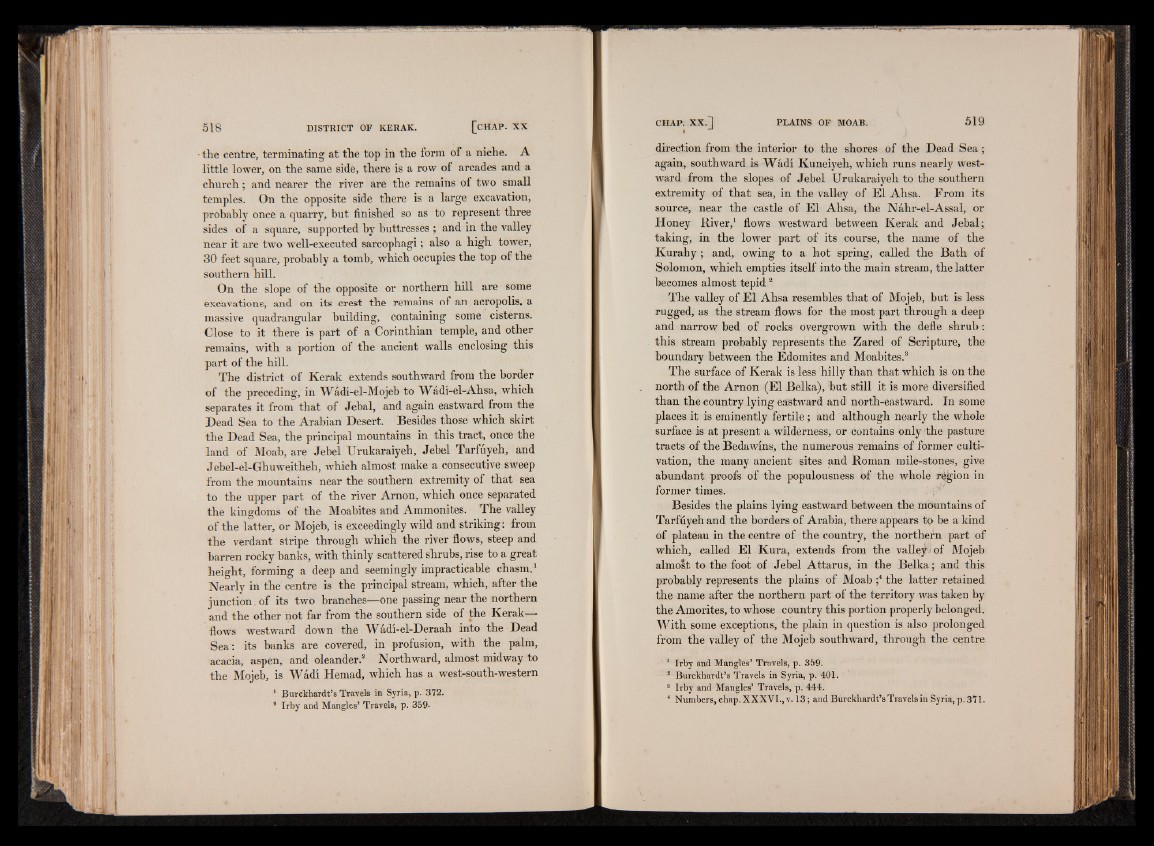
the centre, terminating at the top in the form of a niche. A
little lower, on the same side, there is a row of arcades and a
church; and nearer the river are the remains of two small
temples. On the opposite side there is a large excavation,
probably once a quarry, hut finished so as to represent three
sides of a square, supported by buttresses ; and in the valley
near it are two well-executed sarcophagi; also a high tower,
30 feet square, probably a tomb, which occupies the top of the
southern hill.
On the slope of the opposite or northern hill are some
excavations, and on its crest the remains of an acropolis, a
massive quadrangular building, containing some cisterns.
Close to it there is part of a Corinthian temple, and other
remains, with a portion of the ancient walls enclosing this
part of the hill.
The district of Kerak extends southward from the border
of the preceding, in Wádí-el-Mojeb to Wádí-el-Ahsa, which
separates it from that of Jebal, and again eastward from the
Dead Sea to the Arabian Desert. Besides those which skirt
the Dead Sea, the principal mountains in this tract, once the
land of Moab, are Jebel Urukaraiyeh, Jebel Tarfúyeh, and
Jebel-el-Ghuweitheh, which almost make a consecutive sweep
from the mountains near the southern extremity of that sea
to the upper part of the river Arnon, which once separated
the kingdoms of the Moabites and Ammonites. The valley
of the latter, or Mojeb, is exceedingly wild and striking: from
the verdant stripe through which the river flows, steep and
barren rocky banks, with thinly scattered shrubs, rise to a great
height, forming a deep and seemingly impracticable chasm.1
Nearly in the centre is the principal stream, which, after the
junction, of its two branches—one passing near the northern
and the other not far from the southern side of the Kerak—
flows westward down the Wádí-el-Deraah into the Dead
Sea: its banks are covered, in profusion, with the palm,
acacia, aspen, and oleander.2 Northward, almost midway to
the Mojeb, is Wadi Heinad, which has a west-south-western
1 Burckhardt’s Travels in Syria, p. 372.
! Irby and Mangles’ Travels, p. 359.
direction from the interior to the shores of the Dead Sea;
again, southward is Wadi Kuneiyeh, which runs nearly westward
from the slopes of Jebel Urukaraiyeh to the southern
extremity of that sea, in the valley of El Ahsa. From its
source, near the castle of El Ahsa, the Nahr-el-Assal, or
Honey River,1 flows westward between Kerak and Jebal;
taking, in the lower part of its course, the name of the
Kurahy; and, owing to a hot spring, called the Bath of
Solomon, which empties itself into the main stream, the latter
becomes almost tepid2
The valley of El Ahsa resembles that of Mojeb, but is less
rugged, as the stream flows for the most part through a deep
and narrow bed of rocks overgrown with the defle shrub:
this stream probably represents the Zared of Scripture, the
boundary between the Edomites and Moabites.3
The surface of Kerak is less hilly than that which is on the
north of the Arnon (El Belka), but still it is more diversified
than the country lying eastward and north-eastward. In some
places it is eminently fertile; and although nearly the whole
surface is at present a wilderness, or contains only the pasture
tracts of the Bedawins, the numerous remains of former cultivation,
the many ancient sites and Roman mile-stones, give
abundant proofs of the populousness of the whole region in
former times.
Besides the plains lying eastward between the mountains of
Tarfuyeh and the borders of Arabia, there appears to be a kind
of plateau in the centre of the country, the northern part of
which, called El Kura, extends from the valley) of Mojeb
almost to the foot of Jebel Attarus, in the Belka; and this
probably represents the plains of Moab ;4 the latter retained
the name after the northern part of the territory was taken by
the Amorites, to whose country this portion properly belonged.
With some exceptions, the plain in question is also prolonged
from the valley of the Mojeb southward, through the centre
1 Irby and Mangles’ Travels, p. 359.
a Burckhardt’s Travels in Syria, p. 401.
8 Irby and Mangles’ Travels, p. 444.
4 Numbers, chap. XXXVI., v. 13; and Burckhardt’s Travels in Syria, p. 371.